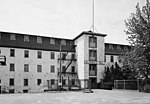Whipple–Angell–Bennett House
1767 establishments in Rhode IslandBuildings and structures in North Providence, Rhode IslandHouses completed in 1767Houses in Providence County, Rhode IslandHouses on the National Register of Historic Places in Rhode Island ... and 2 more
National Register of Historic Places in Providence County, Rhode IslandProvidence County, Rhode Island Registered Historic Place stubs

The Whipple–Angell–Bennett House is an historic house at 157 Olney Avenue in North Providence, Rhode Island. It is a 1+1⁄2-story gambrel-roofed wood-frame structure, four bays wide, with a series of additions extending it to the north and east. Built in 1766, it is one of only two surviving gambrel-roofed 18th-century houses in North Providence. Its additions exhibit the adaptive reuse of and changes in vernacular style in the 19th and early 20th centuries. The interior of the house has retained a great deal of integrity, with original woodwork, plasterwork, and door hardware.The house was listed on the National Register of Historic Places in 1995.
Excerpt from the Wikipedia article Whipple–Angell–Bennett House (License: CC BY-SA 3.0, Authors, Images).Whipple–Angell–Bennett House
Adelaide Avenue,
Geographical coordinates (GPS) Address Nearby Places Show on map
Geographical coordinates (GPS)
| Latitude | Longitude |
|---|---|
| N 41.849166666667 ° | E -71.465 ° |
Address
Adelaide Avenue 12
02911
Rhode Island, United States
Open on Google Maps







